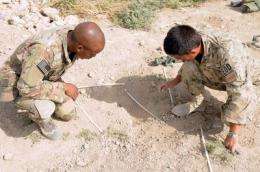RATS research may teach rodents to detect explosives

A rat may never be man's best friend, but the Rugged Automated Training System (R.A.T.S.) research sponsored by scientists with the U.S. Army Research Laboratory, in collaboration with engineers at West Point and the Counter Explosives Hazards Center, will determine if and how these animals can be trained to save Soldiers' lives.
In July, Barron Associates Inc., Charlottesville, Va. was selected for an award under the Small Business Technology Transfer (STTR) program to develop and test a rugged, automated and low-cost system for training rats to detect improvised explosive devices and mines, said Dr. Micheline Strand, chief of the Army Research Office's Life Sciences Division, which manages the program.
"The automated system we're developing is designed to inexpensively train rats to detect buried explosives to solve an immediate Army need for safer and lower-cost mine removal," says William Gressick, senior research engineer and the project's principal investigator at Barron Associates. "Beyond this application, the system will facilitate the use of rats in other search tasks such as homeland security and search-and-rescue operations. In the long-term, the system is likely to benefit both official and humanitarian organizations."

Strand said, "If we can demonstrate that rats can be trained inexpensively to be reliable detectors, then this method would not only lower costs for the Army but would also create new opportunities for using animals to detect anything from mines to humans buried in earthquake rubble."
It is well established that animals are capable of identifying explosives at lower concentrations than abiotic systems. The Department of Defense currently relies on dogs as the animal of choice for explosives detection. The goal of this STTR program is not to replace the use of dogs, but to expand the Army's detection capabilities.
"Training dogs is very expensive. If we can significantly reduce the cost of a trained animal, then we could provide more animals to protect soldiers." Strand said.
Trained rats would also create new opportunities; rats can search smaller spaces than a dog can, and are easier to transport.
Landmines kill between 15,000 and 20,000 people a year, and continue to kill adults and children decades after a conflict ends. An automated system to train rats to find mines could accelerate worldwide efforts to clear mined areas and return mined land to farming or other productive uses.
Provided by U.S. Army Research Laboratory

















